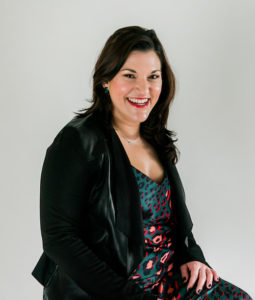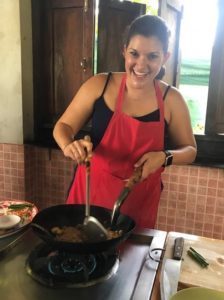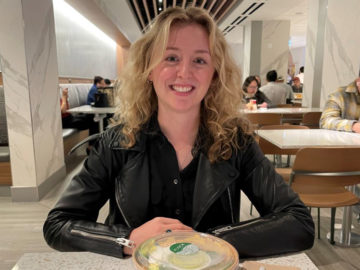Adult Allergies
Dairy Allergy as an Adult Rocked My World
The milk allergy diagnosis as an adult was a shocker. At first I felt desperate, but then I got busy learning to rethink cooking and navigating my "new normal".

Photo: Glenda Arean @ GA Photography
Just a few weeks before my 38th birthday in late 2018, I decided to improve my fitness level and joined a gym. Following a physical assessment, one of the trainers suggested a protein shake after my workouts, which sounded interesting. I went home right after exercising, showered, and excitedly made my new shake.
In minutes, there was a ball in my throat – I thought it was a feeling I’d felt many times before. In the past, I’d been diagnosed with Laryngopharyngeal reflux or LPR, better known as silent acid reflux. As I drank a full cup’s worth of my shake (it was healthy, right?), my eyes became watery.
Oddly, I couldn’t stop sniffling and sneezing. I went to bed to try to relax and watch TV, thinking this was a bad reflux reaction. But as I lay in bed, my throat kept feeling tighter, my eyes got more watery, and the sniffles didn’t stop.
Dozing in and out of sleep, I decided to get up and get ready for bed. But my throat still felt like it had a ball stuck inside and, suddenly, I had to throw up. I rushed to the bathroom and vomited – and my symptoms really took a turn for the worse. My throat felt tighter – I couldn’t even swallow my saliva – and there was a rash on my chest.
During this ordeal, I was texting with a friend. He said this sounded like an allergic reaction. He knew the symptoms, since his son has food allergies. I texted back that I didn’t have allergies. But as I stood at the bathroom sink, gasping for air, my friend recommended that I take any allergy medication on hand. I found Zyrtec, and took a few sips of water, trying to get the pill to go down my swollen throat.
I started to feel better, and my symptoms were subsiding within minutes. But I was left with a raspy throat, and wheezy breathing for a day. I called my doctor, and the physician’s assistant said, “It sounds like an allergic reaction, make an appointment with an allergist right away.”
Off to the Allergist
So that afternoon, I asked over Facebook for allergist recommendations, and my friends kept recommending a specialist who I’d actually seen 13 years earlier. I called and booked his earliest appointment.
When I’d seen this allergist 13 years earlier, it was because I was getting nausea and sometimes vomiting following certain foods, such as mac and cheese, ice cream or café con leche – the Cuban style espresso with lots of milk. Back then, the skin-prick test came back negative for dairy allergy. Following more tests, I had been diagnosed with LPR.
When I got my appointment this time, I told the allergist: “You diagnosed me with reflux, but I think you might have misdiagnosed, because I think I’ve had an allergic reaction.” While relating the episode, I also recalled milder symptoms during a birthday lunch with my niece. My throat had felt tight after eating, so I took a Zyrtec when I got home and later felt fine. But I was baffled, as I thought a food allergy had been ruled out.
After hearing these experiences, my allergist performed a skin-prick test and, just like 13 years prior, it came back negative. He then, sent me for a series of blood tests. This included dairy allergy, but he was also checking for digestive and enzyme issues and more. Since I am a travel editor, however, he prescribed me a set of epinephrine auto-injectors, so I would have these with me – just in case I reacted again while abroad.
Dairy Allergy, So What to Eat?

Fast forward to April 2019. With all the test results in hand, my allergist told me I’m allergic to milk proteins, especially the whey proteins alpha-lactalbumin and beta-lactoglobulin. In component testing, I scored high for raw milk reactivity, and moderate for milk in cooked or processed products. The doctor told me to avoid all -– since I was at considerable risk for another severe reaction.
So suddenly, as an adult, I would have to bid goodbye to cheese, pizza, yogurt, and much more. I left the office feeling defeated.
But when I got home, dejection turned to panic when I realized that almost everything in my pantry contained dairy: granola, yogurts, cookies, crackers, pasta sauce. You name it, it had some form of dairy in it. This also explained why I was always so sniffly at work – my daily breakfast had been Greek yogurt with granola. That made me realize that, all this time, I had been having mild reactions daily for months or possibly years.
Dealing with a diagnosis that completely changes the way you eat and have known to eat your entire life is a huge adjustment. At first, I felt desperate, and at a complete loss trying to figure out food allergy management. I put a plea for help on social media for tips, names of safe brands, and ideas for foods, because I felt lost and overwhelmed.
Another hurdle was explaining to my family and friends why I suddenly couldn’t eat things that I had always eaten, and to have them understand that this was serious. Foods with dairy could put me in hospital – or potentially mean life or death.
Finding My New Normal

Photo: Glenda Arean Photography
But I love to live a full life and was determined to look for solutions. I joined Facebook groups for those on a dairy-free diet. I went to Barnes and Noble and picked up the Allergic Living’s former print magazine – coincidentally, the Spring 2019 issue was all about dairy allergies – and I ordered the Go Dairy Free book. When the book arrived, I sat for hours and hours each night highlighting and learning.
Here I was, 38 years old and desperately trying to navigate this new normal. One thing became obvious: a food allergy diagnosis changes the way you socialize.
I faced my first big challenge later during the week of my diagnosis. It was Easter Sunday, which for my family means a huge potluck picnic at the park. I came armed and ready with specific food, dips, chips, and even a vegan sangria. I knew that in the mass of food that was laid out, none of it would be safe for me – and this was now my new normal.
It has been a learning curve, and one I’m still learning to accept and adapt to. Going out to dinner is still a struggle, and I’ve had to learn to be more open about meal options. I’ve had to be patient when out to dinner with friends, many times having to ask for my own appetizer and opting out of any “family style” meal with them.
When invited over for dinner with family, there have been occasions where I couldn’t eat much of what was served. But they’re trying to adjust, and I’ve learned to share with them brands or meals that are safe for me.
As for grocery shopping, that eats up a lot more time, as I have to double-check every food label. I still get frustrated, I still am coming to grips with always having to speak up about my dairy allergy when out at dinner or traveling. This is the grunt work of the new normal.
Family and Friends Learn, Too

But there are bright spots. At least I have a proper diagnosis and know what I’m supposed to do to avoid a severe reaction. I’m also expanding my horizons, learning to cook dairy-free and experimenting with new foods, and reading any good allergy tips I can get my hands on.
My family and friends are learning alongside me. For Thanksgiving dinner, my sister-in-law made individual, dairy-free portions for me of the sweet potato casserole and stuffing so I could indulge, too. For the yearly Christmas brunch with my best friends, I brought along milk-free pancakes. But the friend hosting surprised me with individual, dairy-free egg bites and hash browns, since much of the food contained dairy.
And on my mom’s birthday, her friend even created a beautiful dairy-free cake. This marked the first time in a year that I’d eaten cake, and it was delicious. I greatly appreciate the thoughtfulness in this moment and the moments when family and friends are making sure there are safe options for me. I know we are all learning how to navigate this new lifestyle together, and there will be many more such moments in my new dairy-free life.
Michelle Marie Arean is a travel writer and editor based in Miami.
Cover Photo by @GlendaAreanPhotography
Related Reading:
Finding the New Normal After a Food Allergy Diagnosis
Milk and Dairy Allergy
Study Finds Doubling of Adult Food Allergy: 5 Important Takeaways
Developing an Adult Food Allergy is a Life-Changer


